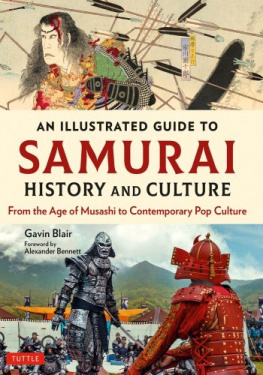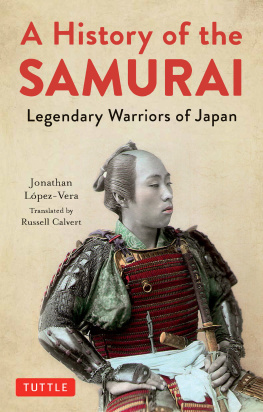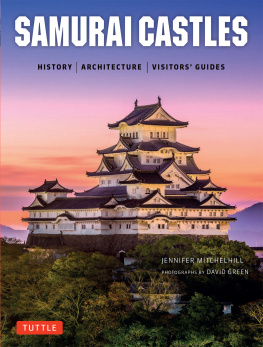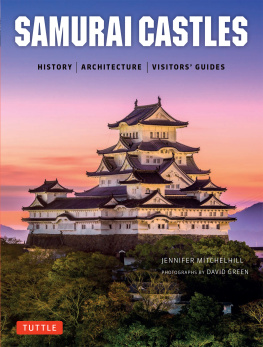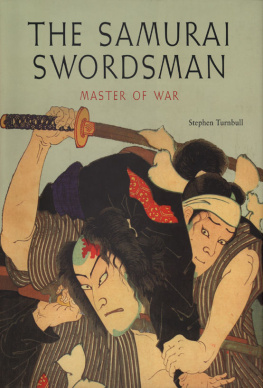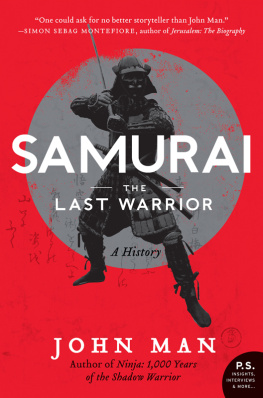BIBLIOGRAPHY
Akuto no seiki , Arai Takashige; Yoshikawa Kobunkan, 1997
Botshin senso , Sasaki Suguru; Chuko Shinsho, 1997
Bunroku-Keisho no eki , Che Guan; Kodansha, 1994
Bushi no seiritsu, Bushizo no soshutsu , Takahashi Masaaki; Tokyo daigaku, 1999
Bushi no tanjo , Seki Yukihiko; NHK books, 2000
Chuusei buke no saho , Futaki Kenichi; Yoshikawa Kobunkan, 1999
Edojidai no mikataga kawaruhon , Amino Yoshihiko et al; Yosensha, 1998
Genpei kassen no Kyozo wo hagu , Kawai Yasushi; Kodansha, 1996
Hideyoshi no yabo to gosan , Kasaya Kazuhiko et al; Buneido, 2000
Hideyoshi to Momoyama bunka , Watanabe Takeshi et al; Osakajo Tenshukaku Museum, 1997.
Ikusa , Fukuda Toyohiko; Yoshikawa Kobunkan, 1993
Jidai shozoku ; Kyoto shoin, 1995
Kamakura bushi monogatari , Konno Nobuo: Kawade shobo shinsha, 1991
Kassen engi emaki , Yoshida Seiichi et al; Heibonsha, 1979
Katchyu no subete , Sasama Yoshihiko; PHP kenkyujo, 1997
Moko shurai ekotoba , Komatsu Shigemi; Chuokoronsha, 1990
Moko shurai , Amino Yoshihiko; Shogakukan, 1992
Moko shurai , Kaitsu Ichiro; Yoshikawa Kobunkan, 1997
Nagashino-Shitaragahara kassen no shijitsu , Nawa Yumio; Yuzankaku, 1999
Nazotoki chuseishi , Imatani Akira; Senyosha, 1997
Nihon chuseishizo no saikento , Amino Yoshihiko et al; Yamakawa shuppan, 1998
Nihon kassen zenshu , Kuwata Tadachika; Akiyama shoten, 1990
Nihon kassen zuten , Sasama Yoshihiko; Yuzankaku, 1997
Nihon no bijutsu no.146 , Miya Tsugio; Shibundo, 1946
Nihon no kassen bugu jiten , Sasama Yoshihiko; Kashiwa shobo, 1999
Nihon no katchyu ; Kyoto Museum, 1987
Nihon no rekishi , Ienaga Saburo; Horupu sha, 1982
Nihon rekishi ; Gakken, 1991
Nihon senjin saho jiten , Sasama Yoshihiko; Kashiwa shobo, 2000
Nobunaga no sengoku gunjigaku , Fujimoto Masayuki; Yosensha, 1997
Onin no ran , Takano Kiyoshi et al.; Gakken, 1994
Osakanojin , Takano Kiyoshi et al.; Gakken, 1994
Sekigahara kassen , Kasaya Kazuhiko; Kodansha, 1994
Sekigahara kassen , Owada Tetsuo et al; Shinjinbutsu oraisha, 2000
Sekigahara , Nakai Hitoshi et al.; Gakken, 2000
Sengoku kassen no joshiki ga kawaru hon , Fujimoto Masayuki; Senyosha, 1999
Sengoku kassen no Kyojitsu , Suzuki Naoya; Kodansha, 1998
Sengoku kassen, honto wa kodatta , Fujimoto Masayuki; Yusenshya Mook,1996
Teppo denrai, Udagawa Takehiko; Chuko shinsho, 1997
Teppo to Nihonjin , Suzuki Masaya; Yosensha, 1997
Toyotomi Hideyoshi kassen soran , Yasui Hisayoshi et al; Shinjinbutsuorai sha, 1986
Toyotomi Hideyoshi , Nagaoka Keinosuke et al; Gakken, 1996
Toyotomi Hideyoshi , Yasui Hisayoshi; Shinjinbutsuorai Sha, 1996
Yoroi to kabuto , Yamagami Hachiro et al; Colour books
Yumiya to token , Kondo Yoshikazu; Yoshikawa Kobunkan, 1997
Zohyo tachino senjo , Fujiki Hisashi; Asahishinbun sha, 1996
CHRONOLOGY
The dates are given as A.D.
792 Nara government abolishes provincial corps and founds kondeisei system.
Early Heian Period
794 Kanmu Emperor moves court to Kyoto.
935 Taira Masakado kills his uncle Kunika and seizes power in Kanto.
Fujiwara Sumitomo rebels in Kyushu.
940 Masakado killed in battle.
1028 Taira Tadatsune rebels in Kanto.
1031 Minamoto Yorinobu puts down Tadatsunes revolt. 1035 Conflict between the warrior monks of Enjo and Enryaku temples.
1036 Conflict between the Todai and Kofuku temples.
1051 Abe family in Mutsu revolts against imperial courtthe start of the Zenkunen-no-eki, or Nine Years War.
1056 Minamoto Yoriyoshi appointed shogun to pacify Mutsu.
1062 Minamoto Yoshiie finally crushes Abe revolt.
1083 Yoshiie intervenes in internal feuding of Kiwohara family in Dewa.
1086 Former emperor Shirakawa opens In (cloistered office) at imperial court.
1091 Minamoto Yoshiie refused entry to Kyoto with his forces.
1095 Hokumen-no bushi appointed to guard In .
1129 Taira Tadamori suppresses pirates of Inland Sea.
Late Heian Period
1156 Hogen insurrection in Kyoto put down.
1159 The Heishi acquire military supremacy over the Minamoto family.
1167 Taira Kiyomori appointed daijodaijin (court prime minister).
1180 Minamoto Yoritomo and Kiso Yoshinaka rise against the Heishi; beginning of the Genpei War.
Yoritomo founds monchujo (financial court) as departments of bakufu in Kamakura.
1183 Kiso Yoshinaka defeats Heishi and enters Kyoto.
1184 Minamoto Yoshitsune defeats the Heishi at Ichinotani.
Minamoto Yoritomo founds kumonjo (secretariat).
1185 Taira family perish in sea battle of Dan-no-ura.
Kamakura Period
1192 Minamoto Yoritomo appointed as shogun.
1202 Yoriie becomes second shogun.
1203 Hojo Tokimasa assassinates Yoriie at Shuzen temple.
1204 Minamoto Sanetomo became third shogun.
1205 Hojo Tokimasa becomes regent.
1219 Assassination of Sanetomo ends Minamoto Yoritomos blood-line.
1221 Retired emperor Go-Tobas plot against Kamakura bakufu fails.
1232 Regent Hojo Yasutoki proclaims gosei baishi kimoku (samurai code).
1268 Envoys from Kublai Khan arrives at Dazaifu in Kyushu.
1274 Yuan/Mongol army lands in Kyushu and is repulsed ( Bunei-no-Eki ).
1281 Yuan/Mongol armys second invasion fails ( Kouanno-Eki ).
1297 Bakufu decrees cancellation of debts to aid impoverished provincial samurai.
1321 Go-Daigo Emperor abolishes In office and governs by himself.
1331 Go-Daigo Emperor raises army to destroy Kamakura bakufu.
1333 Fall of Kamakura bakufu.
1334 New imperial government established ( Kenmu-noshinsei ).
1335 Ashikaga Takauji revolts against new government.
Muromachi Period
1336 Kusunoki Masashige defeats Takauji who flees to Kyushu. Takauji strikes back, defeats Masashige at Minatogawa. Takauji establishes bakufu in Kyoto and sets Komyo on throne, beginning Nanbokuchoage of rival courts in Kyoto and Yoshino.
1338 Ashikaga Takauji appointed shogun.
1368 Ashikaga Yoshimitsu becomes third shogun.
1378 Yoshimitsu moves bakufu to Muromachi in Kyoto. 1392 Two rival courts integrated by Yoshimitsu.
1402 Relations established between Yoshimitsu and Ming Chinese emperor.
1428 First ikki revolt by disaffected poorer classes. 1429 Ashikaga Yoshinori becomes shogun.
1441 Akamatsu Yoshisuke assassinates Yoshinori.
1457 Ota Dokan constructs Edo Castle in Tokyo.
1467 Beginning of Onin War in Kyoto.
1471 Rennyo opens halls for Buddhist sect Jodo-shin-shu or Ikko-shu .
1477 End of Onin War.
1485 Ikki seize control in Yamashiro.
1488 Ikki rising in Kaga.
1495 Hojo Soun takes Odawara and seizes power in Kanto region.
1496 Rennyo starts building Ishiyama Honganji temple at Osaka.
1504 Tokusei-ikki riots in Kyoto demanding revocation of debt.
1531 Ikko-ikki forces defeat warlord Asakura Norikage.
1543 Portuguese bring firearms to Japan.
1549 St. Francis Xaviers Christian mission to Nagasaki.
1553 Takeda Shingen and Uesugi Kenshin fight first battle at Kawanakajima.
1555 The Mori destroy the Sue family.
1560 Oda Nobunaga kills Imagawa Yoshimoto at battle of Okehazama.
1563 Ikko-ikki in Mikawa.
1568 Oda Nobunaga enters Kyoto with shogun Ashikaga Yoshiaki.
1570 Nobunaga defeats Asai and Asakura families at Anegawa.
1571 Nobunaga attacks Ikko-ikki in Nagashima; and destroys Enryaku temple.
1572 Takeda Shingen defeats Tokugawa Ieyasu at Mikatagahara.
1573 Fall of the Muromachi bakufu.
1575 Oda/Tokugawa allied army defeats Takeda Katsuyori at Nagashino.
1576 Nobunaga starts building Azuchi Castle.
Momoyama Period


